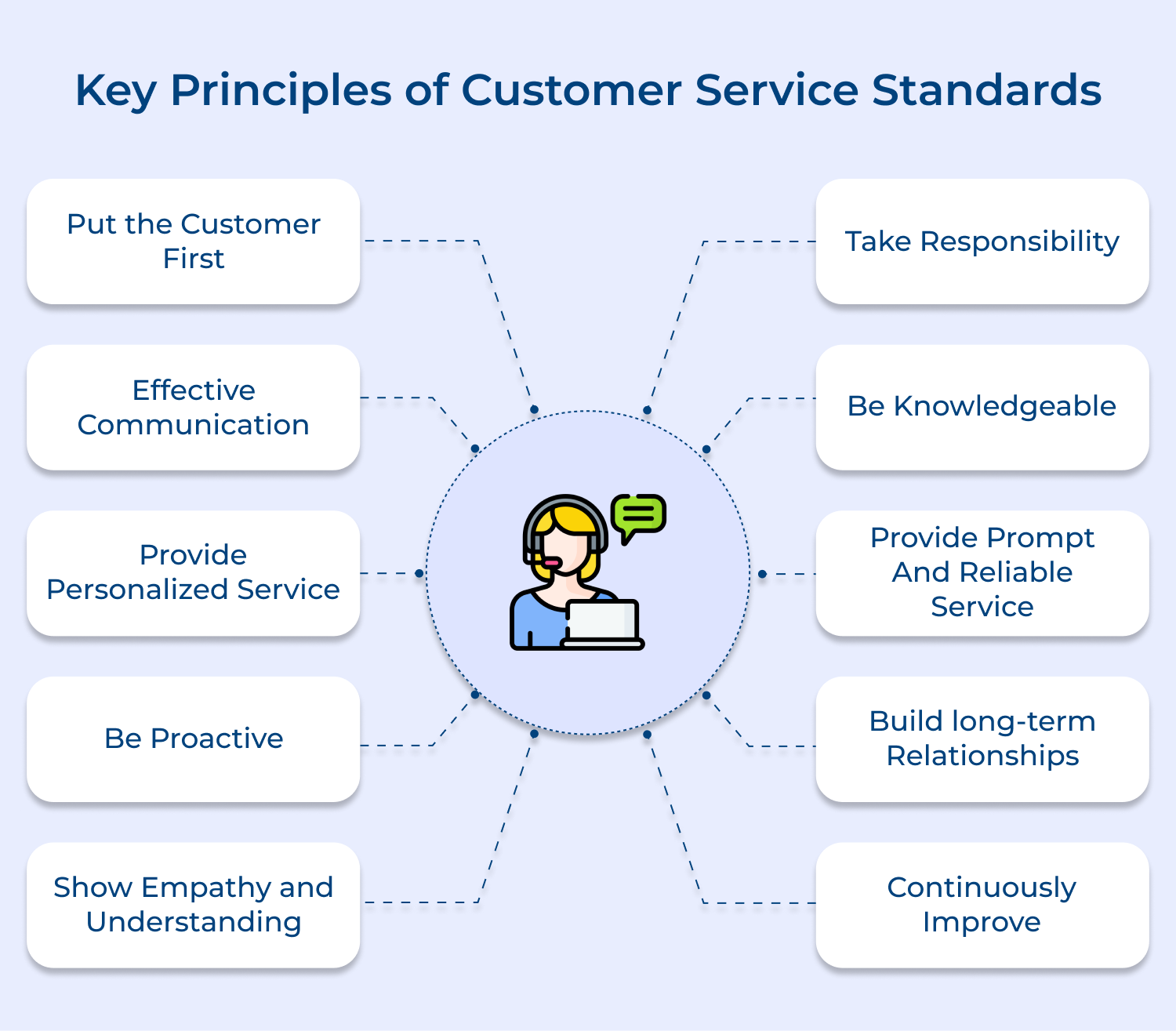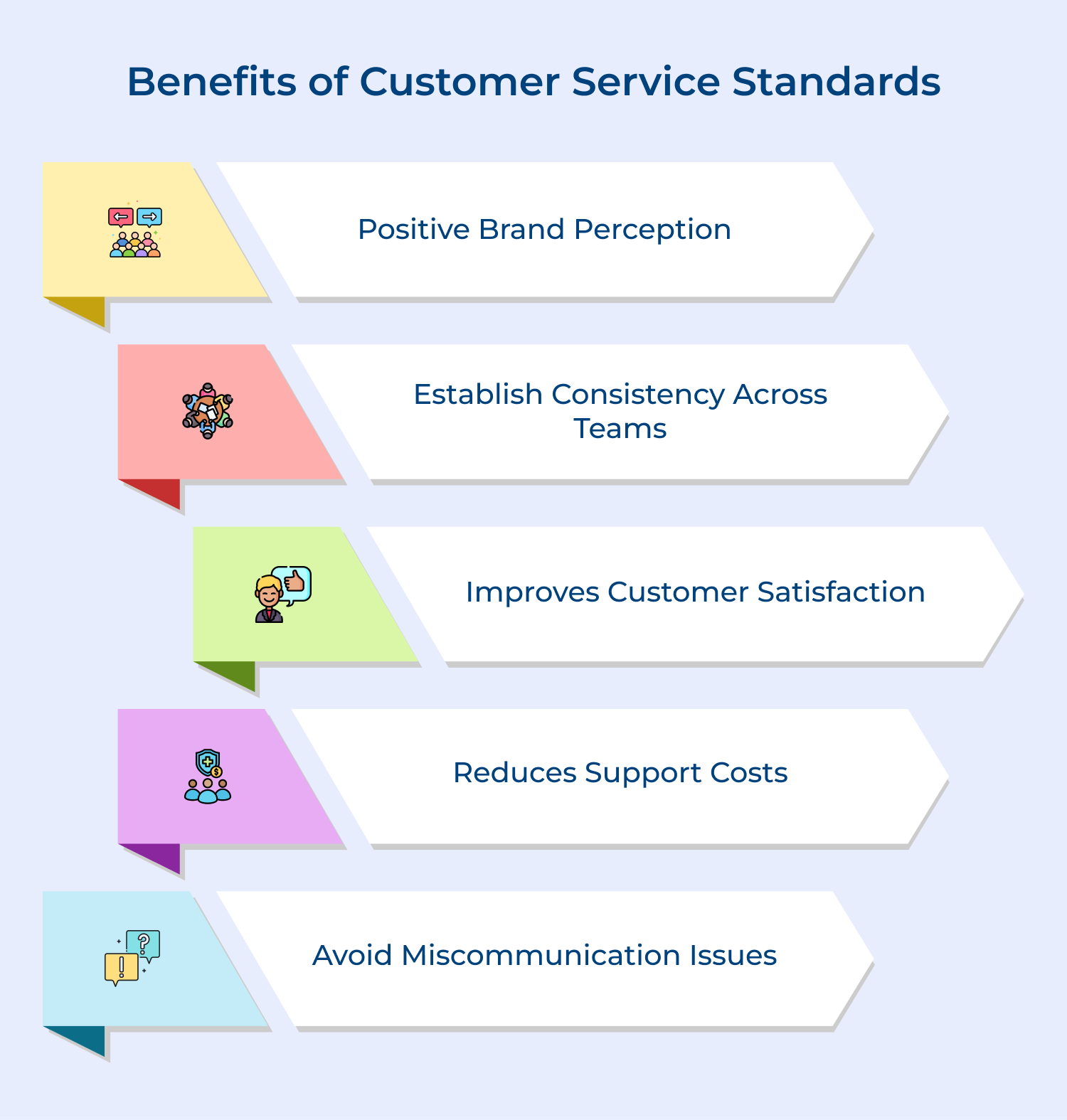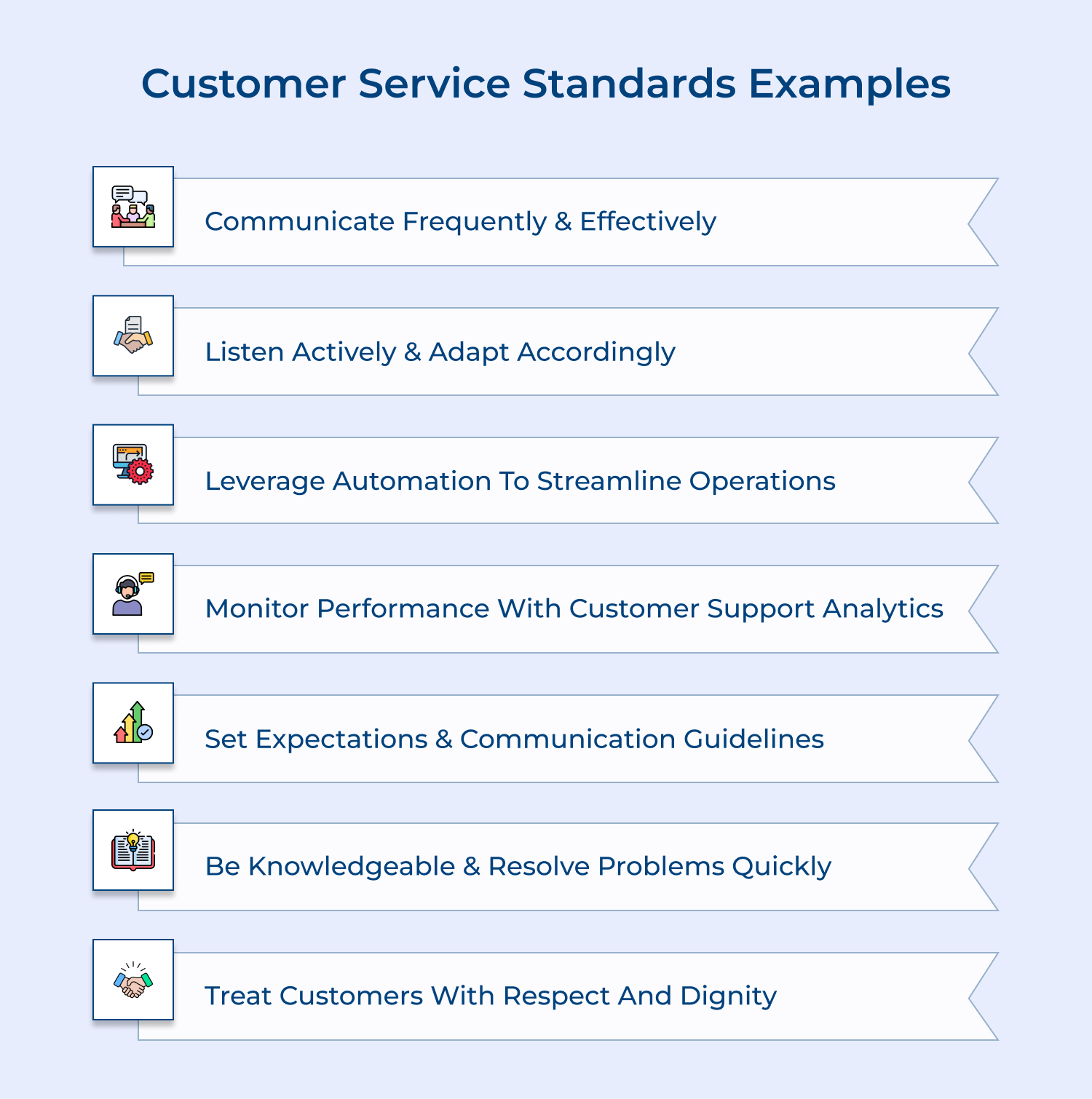Here are the key best practices and tips to take your standards of customer service above as well as beyond expectations.
1. Communicate Frequently & Effectively
Encourage your staff members to update their clients regularly on progress throughout any process or course of action the company takes.
Avoid over-promising or under-delivering by setting reasonable expectations upfront. It will build trust between both parties and strengthen ties over time, leading to better relationships with current users as well as those considering using your services.
How to Implement?
- Establish a clear communication structure: Set expectations for communication to ensure messages are relayed efficiently.
- Investigate customer needs and preferences: Find out what methods customers prefer to receive information from you.
- Encourage two-way dialogue: Simple feedback mechanisms such as quick polls or surveys will help you get the insights you need.
Here is a template to help you communicate with your customers promptly and effectively:
Provide clear and concise information: When responding to customers, ensure your message is easy to understand. Use simple language and avoid jargon or technical terms that might confuse them.
“Dear [Customer Name],
I apologize for the inconvenience you have experienced with [specific issue]. Our team is currently investigating the matter and we will provide you with a detailed update by [specific date/time].
Thank you for your understanding, and if you have any additional questions, please feel free to ask.
Sincerely,
[Your Name]”
2. Listen Actively & Adapt Accordingly
Too often we get caught up in our plans instead of listening attentively to what our clients have told us. It can lead to misunderstandings or miscommunication among the parties involved.
Being an active listener means understanding exactly what we hear from them so we can tailor the solution accordingly.
How to Implement?
- Demonstrate empathy: Put yourself in your customer’s shoes and try to understand their problems from their perspective to provide effective solutions.
- Understand their expectations: Ensure you know exactly what your customers want from the interaction and strive to meet or exceed those expectations.
- Offer consistent support: Deliver consistent customer service across different platforms and channels so that customers can always rely on you for help when needed.
The below template can help you listen to your customers actively:
Engage actively: When a customer reaches out with a concern, actively engage in the conversation. Encourage them to share details about their issue or feedback and demonstrate genuine interest.
“Dear [Customer Name],
Thank you for reaching out to us.
We appreciate you taking the time to share your concerns regarding [specific issue]. It is essential for us to better understand your experience and we would be grateful if you could provide us with more details. It will enable us to properly address your concerns and find a suitable solution.
Please feel free to share any additional information or provide examples that can help us fully grasp the situation. Your feedback is valuable to us and we are committed to resolving this matter to your satisfaction.
Regards,
[Your Name]”
3. Leverage Automation To Streamline Operations
Implement automation techniques/tools such as chatbots or automated emails whenever possible to streamline operations and offer 24/7 support without having human resources engaged constantly.
Using such tools frees up time for other support activities while still delivering high levels of customer satisfaction through prompt responses, accurate advice, and interesting content.
How to Implement?
- Allows customer support reps to spend more time focusing on customer’s needs and helping them navigate any problems they may encounter.
- Automating tedious, time-consuming tasks like sending bulk emails or following up with inquiries can free up resources and help improve the efficiency of overall operations.
- Utilizing an integrated Customer Relationship Management system (CRM) can make it easier for support reps to access client information quickly and confidently.
4. Monitor Performance with Customer Support Analytics
Analytics can provide deep insights into customer behavior which can improve decision-making.
From understanding revenue cycle efficiency (RCE), calculating KPI trends over time, or monitoring churn rates – performances monitored with analytics drive more meaningful impact. Adopting analytics allows businesses to make intelligent decisions swiftly while improving workflows efficiently thereby increasing customer satisfaction overall.
How to Implement?
- Track the right metrics: Using metrics like response rate, resolution time and customer experience scores helps to monitor the performance of your support operations.
- Use automated tools: AI-enabled analytics or self-service portals can greatly improve the speed and accuracy of your customer support analytics.
- Analyze results regularly: Implement proactive measures throughout your organization by tracking the results of your customer support analytics regularly.
5. Set Clear Expectations & Communication Guidelines
Customers expect clear expectations from companies with whom they interact. If these needs aren’t met consistently, it sets up misunderstandings that could cost you long-term loyalty from your customers.
Set realistic timelines that allow sufficient time for feedback-gathering steps like surveys or interviews before delivering solutions to ensure the timely execution of requests made by customers.
Creating an established communications protocol is essential for providing exceptional customer service experiences because it clearly outlines how communications happen between teams and clients.
How to Implement?
- Ensure that all employees clearly understand the company’s goals for customer service performance.
- Establish a set of written policies, processes, calls-to-action, and other elements of your customer service strategy that guide each employee’s approach.
- Foster an open environment where both customers and employees feel empowered to voice their concerns or ask questions without fear of judgment.
6. Be Knowledgeable & Resolve Problems Quickly
One of the keys to excellent customer service is having staff members who are knowledgeable about products and services.
Not only the key features but also how they can be used best while resolving customers’ issues quickly through virtual spaces or face-to-face interactions. Deploy AI chatbots that help instantly resolve some basic inquiries without human intervention and also ensure personalized responses when needed.
How to Implement?
- Consistently stay up-to-date with trends, news and industry developments.
- Ask customers detailed questions to get a full understanding of the situation before proposing a solution.
- Offer alternative solutions or connections with other services in addition to finding a resolution for the issue at hand.
7. Treat Customers with Respect and Dignity
Did you know – If customers don’t feel respected during interactions, they’ll likely take their business elsewhere?
Make sure customers understand they’re dealing with knowledgeable employees who will listen to their concerns without judgment. Consider offering rewards or discounts as a token of appreciation for being patient – It can help make frustrated customers happier.
How to Implement?
- Lead by example and show customers respect in all interactions.
- Remember that everyone deserves to be treated with courtesy and understanding.
- Consistently reinforce standards of respectful behavior throughout your organization.
Challenges While Implementing Customer Service Standards and Their Solution
Implementing and managing customer support standards can be challenging, as it requires a shift in the way an organization operates.
Here’s an overview of seven challenges you should avoid to maximize the service outcomes.
1. Lack of Employee Training
One of the biggest challenges in implementing customer service standards is the lack of proper training for employees. It is crucial to provide comprehensive training programs that equip employees with the necessary skills and knowledge to address customer needs effectively.
Regular training sessions should be conducted to update employees on new industry trends and best practices.
Solution:
- Invest in customer service training programs that cover various aspects such as communication skills, conflict resolution, empathy and product knowledge.
- Encourage employees to attend workshops and seminars to enhance their skills continuously.
2. Inconsistent Service Quality
Maintaining consistent service quality across all customer touchpoints can be challenging, especially in businesses with multiple locations or departments. Customers expect the same level of service, regardless of whom they interact with.
Solution:
- Establish detailed customer service standards and guidelines that outline the expected level of service at every touchpoint.
- Regularly monitor and evaluate service quality through mystery shopping or customer surveys.
- Provide feedback and coaching to employees to ensure consistency.
3. Limited Communication Channels
Customers demand multiple communication channels to reach out to businesses. Some companies may struggle to offer a diverse range of channels, limiting their ability to meet customer preferences.
Solution:
- Identify the communication channels that are most relevant to your target audience and industry.
- Invest in the necessary infrastructure to provide customer support through phone, email, live chat, and social media.
- Monitor these channels regularly and respond promptly to customer queries or complaints.
4. Handling Difficult Customers
Dealing with difficult customers can be emotionally draining for employees, and if not handled correctly, it can impact the overall customer experience. Some employees may lack the skills to handle challenging situations, leading to frustration and potential loss of business.
Solution:
- Provide employees with training on handling difficult customers effectively.
Teach them techniques such as active listening,
- Maintaining a positive attitude, and offering solutions instead of engaging in arguments.
Encourage the use of empathy and patience to de-escalate tense situations.
5. Lack of Feedback Mechanisms
Without proper feedback mechanisms, it becomes challenging to gauge customer satisfaction and identify areas for improvement. Without feedback, businesses may continue to make the same mistakes or fail to meet evolving customer expectations.
Solution:
- Implement feedback mechanisms such as customer surveys, online reviews, or feedback forms.
- Actively analyze the feedback to identify patterns, trends and areas of improvement.
- Use the feedback to make data-driven decisions and enhance the overall customer experience.
6. Balancing Personalization and Efficiency
Providing personalized customer service can be time-consuming and requires a significant investment of resources. Balancing personalization with efficiency is a challenge that businesses often face.
Solution:
- Utilize customer relationship management (CRM) systems and other technologies to streamline personalized service. These systems can store customer information, preferences and history, enabling employees to tailor their interactions.
- Automated processes can help minimize administrative tasks and free up time for more meaningful interactions.
7. Employee Empowerment
Empowering employees to make decisions and resolve customer issues on their own is crucial for delivering exceptional customer service. Some companies struggle with empowering employees, leading to delays in issue resolution and a negative customer experience.
Solution:
- Establish a culture of empowerment by providing employees with the necessary authority and guidelines to resolve customer issues independently.
- Encourage employees to take ownership of customer problems and empower them to make decisions within predefined limits.
10 Customer Service Policies to Implement
A well-defined customer service policy is crucial in ensuring customer satisfaction and loyalty. Here are 10 key elements to include in your customer service policy:
- Prompt response time: Make it a priority to respond to customer concerns promptly. Set specific targets for response times and ensure that your team is trained to meet them.
- Clear communication: Use clear language when communicating with customers. Avoid using jargon or technical terms that may confuse or alienate them.
- Personalized approach: Treat each customer as an individual and tailor your interactions accordingly. Address customers by their name and show genuine empathy towards their concerns.
- Respectful and courteous behavior: Train your employees to always maintain a respectful attitude towards customers, regardless of the situation. Encourage positive language and discourage any form of disrespect.
- Positive problem-solving: Empower your employees to take ownership of customer problems and find satisfactory solutions. Encourage creative thinking and provide the necessary resources to resolve issues positively.
- Transparency and honesty: Be transparent with your customers about product/ service details, pricing and any potential limitations. Honesty builds trust as well as helps to maintain long-term relationships.
- Consistency in service: Ensure that your customer service policy is consistently applied across all channels and interactions. Customers should receive the same level of service, whether they contact you via phone, email, or social media.
- Continuous improvement: Regularly analyze customer feedback to identify areas of improvement. Implement measures to enhance your customer service based on their suggestions and complaints.
- Effective training and development: Invest in training programs to equip your employees with the necessary skills and knowledge to deliver excellent customer service. Regularly update their training to align with changing customer expectations and market trends.
- Empathy and understanding: Foster a culture of empathy within your organization. Train your employees to put themselves in the customers’ shoes and understand their needs, frustrations as well as concerns.
Customer Service Standards Define Your Brand Image
Customer service defines a brand’s reputation. Many businesses have come to rely on customer service as a key part of their branding efforts. One way to ensure your business stands out in the landscape of customer service is by defining and implementing customer service standards. Read on to learn more about how customer service standards define your brand image.
Customer service standards provide an outline of the core philosophies and expectations that you want all employees to adhere to when providing customer support. Setting clear standards helps to ensure everyone knows what they should be doing, how they should be working with customers and the attitude each should carry when communicating with those customers.







